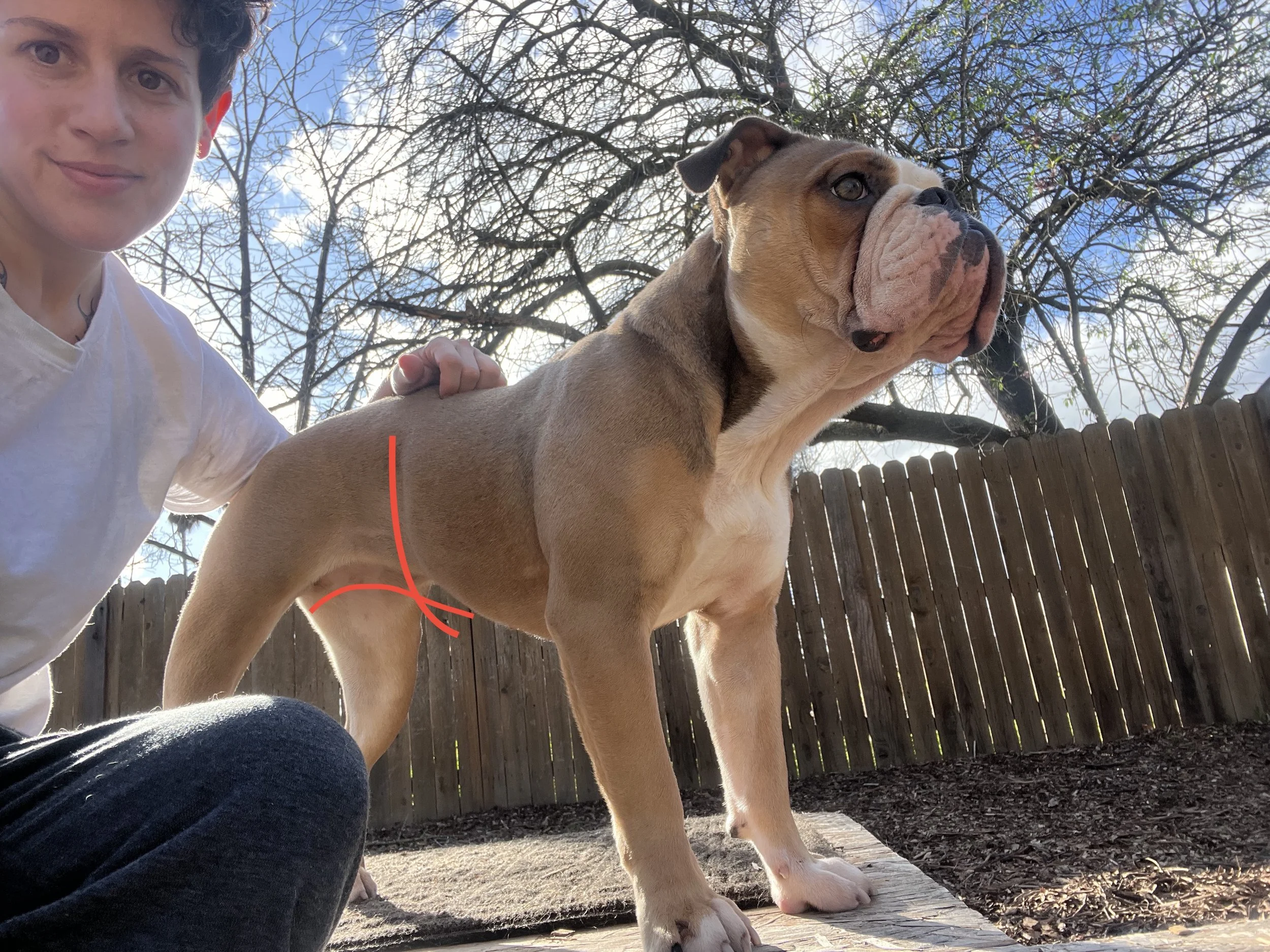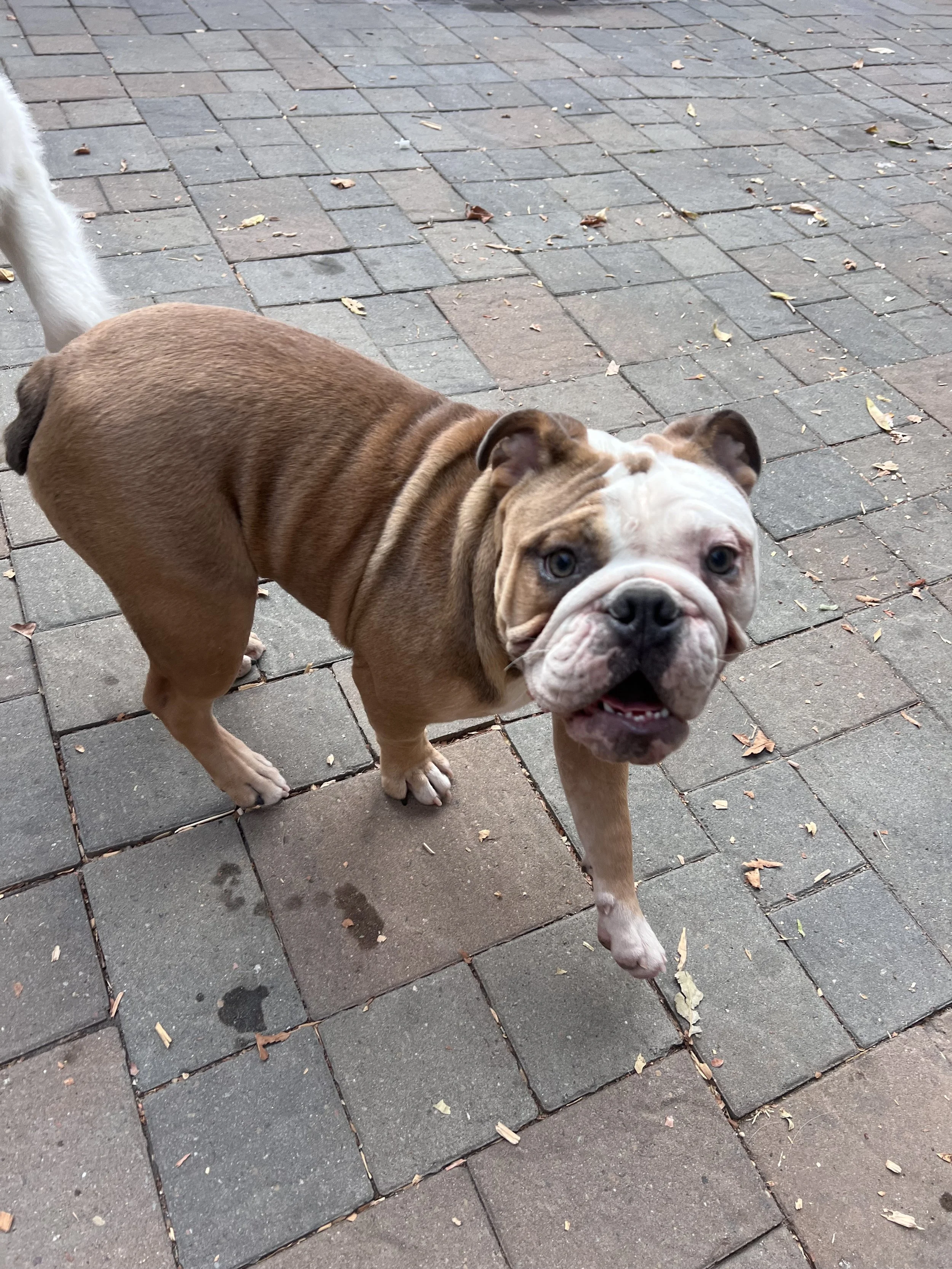Is My Dog Overweight?
As pet parents, we all want our dogs to live happy, healthy lives. Just like people, dogs need a balanced diet and regular exercise to maintain their health, and managing weight is a big part of that. Unfortunately, many dogs are overweight, which can lead to health issues like arthritis, diabetes, heart disease, and a shortened lifespan. If you’re considering doing a training program with your dog, getting to a healthy weight can help them be more motivated for training—this is especially important if you have an anxious dog. The good news is that there are some simple ways to determine if your dog may be carrying a few too many pounds.
Here’s how to tell if your dog is overweight and what you can do to help them get back on track.
1. Check Their Shape
“Penny,” the English Bulldog, has a defined waist and slight rib visibility.
One of the easiest ways to tell if your dog is overweight is by looking at their shape. A healthy dog should have an “hourglass” figure when viewed from above. That means their waist should be slightly narrower than their chest and hips. When looking from the side, you should see a slight tuck-up of their belly—meaning the abdomen should be higher than the ribcage.
Signs your dog may be overweight:
• A round, sausage-like body shape with no visible waistline.
“Penny,” the English Bulldog, when she was overweight. No visible waistline, no rib visibility, and extra fat on her body.
• A belly that hangs down rather than tucks up.
• Fat deposits around the neck, chest, and base of the tail.
2. Feel Their Ribs
Another effective way to gauge your dog’s weight is to feel along their ribcage. Ideally, you should be able to feel each rib easily with a thin layer of fat covering them, similar to how the back of your hand feels when you rub your fingers over your knuckles.
Signs of excess weight:
• You can’t feel your dog’s ribs without pressing down.
• There’s a thick layer of fat over the ribs, making them hard to find.
3. Check Their Energy Levels
Overweight dogs often have less energy and may seem reluctant to go for walks, play, or climb stairs. They may also be less heat tolerant, and become out of breath more easily. If you used to hit the Bay Area hills with your dog, but now they seems to tire easily, it might be due to the extra weight. While there could be other health reasons for decreased energy, it’s worth considering weight gain as a possible cause, especially in middle-aged or older dogs.
4. Use a Body Condition Score (BCS)
Veterinarians often use a tool called the Body Condition Score (BCS) to assess a dog’s weight. This scoring system ranges from 1 to 9, where a score of 1 is severely underweight, 5 is ideal, and 9 is severely overweight. You can ask your vet to help you assess your dog’s BCS, or there are charts online that can guide you. A BCS score of 6 or higher generally indicates that a dog is overweight. Remember that different dogs have different “ideal” body conditions — so a Whippet in a healthy condition is going to look different than a German Shepherd.
5. Weigh Your Dog Regularly
Regularly weighing your dog and keeping track of any changes is one of the best ways to catch weight gain early. Smaller dogs can usually be weighed on a standard bathroom scale; for larger breeds, you may need a veterinary scale. Knowing your dog’s ideal weight range is also helpful, so ask your vet what’s healthy for your dog’s breed, age, and body type. When it comes to feeding your dog, do not adhere to feeding guidelines on your dog food bag—if your dog is overweight, the bag will say they require more food, which is going to keep them overweight or even exacerbate their condition.
What to Do If Your Dog Is Overweight
If you think your dog might be overweight, it’s important to take action. Here are some steps to get started.
1. Consult Your Vet: Before making any major changes, talk to your vet. They can help confirm if your dog is overweight and recommend a safe plan for weight loss. I absolutely love Moraga Veterinary Hospital in the Bay Area, for many reasons—one of those reasons is because they have always been excellent at understanding healthy dog condition, and advocating for fit dogs. Some veterinarians are so used to seeing obese dogs, dogs that are less significantly overweight may seem to be in better shape to them than they actually are.
2. Adjust Their Diet: Overweight dogs often benefit from a lower-calorie diet with balanced nutrition. Your vet may recommend a special weight-loss food or help you figure out proper portion sizes. However, usually reducing portion size is enough to get their weight under control. If they are big eaters and act hungry with less food, try adding green beans to their meals, which can add bulk without as much calories.
3. Increase Exercise: Try to gradually increase your dog’s activity levels with walks, play sessions, and other forms of exercise that they enjoy. Swimming can also be a great low-impact exercise for dogs with joint issues. Training your dog to be safe off-leash means you can give them opportunities to run, burning more calories. The Bay Area has so many amazing open spaces to hike with your dog and get lots of exercise.
4. Limit Treats: Treats can add a lot of extra calories to your dog’s diet, so be mindful of how many you’re giving them. Consider switching to low-calorie treats or even using bits of their regular food as rewards.
5. Monitor Progress: Regular weigh-ins and BCS checks will help you track your dog’s progress and adjust their diet and exercise as needed.
Final Thoughts
Helping your dog maintain a healthy weight is one of the best things you can do for their long-term health. By regularly checking their shape, feeling their ribs, and keeping an eye on their energy levels, you’ll be able to spot any changes early. If you’re ever unsure about your dog’s weight, your vet is a great resource for advice and support.
With patience and consistency, you can help your dog shed those extra pounds and keep them feeling their best for years to come.

